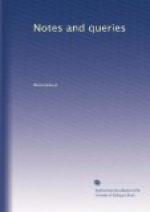This is strange after the explicit statement in the Law Mag., and I shall be obliged to receive through the medium of your useful pages any information regarding the work in question.
F.R.H.
Christopher Barker’s Device.—I have often been puzzled to understand the precise meaning of the inscription on Christopher Barker’s device. Whether this arises from my own ignorance, or from any essential difficulty in it, I cannot tell; but I should be glad of an explanation. I copy from a folio edition of the Geneva Bible, “imprinted at London by Christopher Barker, printer to the Queene’s Majesty, 1578.”
The device consists of a boar’s head rising from a mural crown, with a scroll proceeding from its mouth, and embracing a lamb in the lowest fold. The inscription on this scroll is as follows:—
“Tigre . Reo.
Animale . Del.
Adam . Vecchio.
Figliuolo . Merce.
L’Evangelio . Fatto.
N’Estat . Agnello.”
I venture my own solution:—The tiger, the wicked animal, of the old Adam, being made, thanks to the Gospel, a son, is hence become a lamb.”
I presume N’Estat to be an abbreviation of “ne e stato.” Any correction or illustration of this will oblige.
C.W. BINGHAM.
Bingham’s Melcombe, Blandford.
* * * * *
REPLIES.
LICENSING OF BOOKS.
(Vol. ii., p.359.)
On the 12th November, 5 & 6 Philip and Mary, 1558, a bill “That no man shall print any book or ballad, &c., unless he be authorized thereunto by the king and queen’s majesties licence, under the Great Seal of Englande,” was read for the first time in the House of Lords, where it was read again a second time on the 14th. On the 16th it was read for the third time, but it did not pass, and probably never reached the Commons; for Queen Mary died on the following day, and thereby the Parliament was dissolved. (Lords’ Journal, i. 539, 540.) Queen Elizabeth, however did by her high prerogative what her sister had sought to effect by legislative sanction. In the first year of her reign, 1559, she issued injunctions concerning both the clergy and the laity: the 51st Injunction was in the following terms:—
“Item, because there is great abuse in the printers of books, which for covetousness chiefly regard not what they print, so they may have gain, whereby ariseth the great disorder by publication of unfruitful, vain, and infamous books and papers; the queen’s majesty straitly chargeth and commandeth, that no manner of person shall print any manner of book or paper, of what sort, nature, or in what language soever it be, except the same be first licensed by Her Majesty by express words in writing, or by six of her privy council; or be perused and licensed by the Archbishops of Canterbury and York, the Bishop of London, the chancellors




